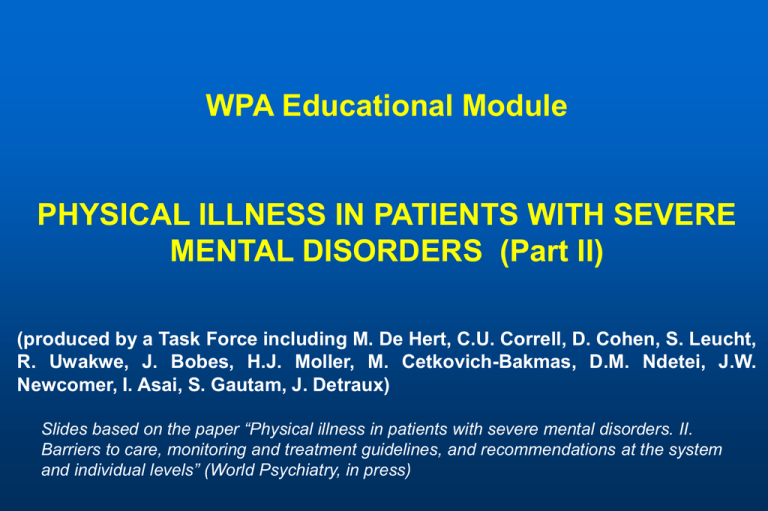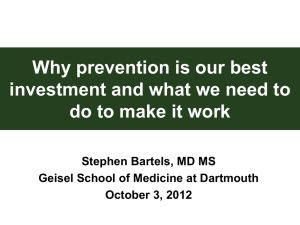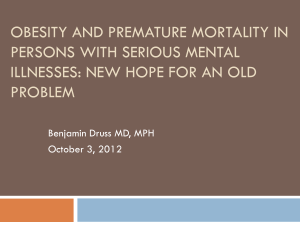
WPA Educational Module
PHYSICAL ILLNESS IN PATIENTS WITH SEVERE
MENTAL DISORDERS (Part II)
(produced by a Task Force including M. De Hert, C.U. Correll, D. Cohen, S. Leucht,
R. Uwakwe, J. Bobes, H.J. Moller, M. Cetkovich-Bakmas, D.M. Ndetei, J.W.
Newcomer, I. Asai, S. Gautam, J. Detraux)
Slides based on the paper “Physical illness in patients with severe mental disorders. II.
Barriers to care, monitoring and treatment guidelines, and recommendations at the system
and individual levels” (World Psychiatry, in press)
Background
Rates of undiagnosed and untreated medical illnesses are
higher in individuals with severe mental illness (SMI),
compared to the general population
Disparities in health care access, utilization and provision,
contribute to these poor physical health outcomes
Confluence of patient, provider, treatment and system factors
has created a situation in which access to and quality of health
care is problematic for individuals with SMI
Many psychiatrists consider their primary or, even, sole
function to provide clinical care in terms of psychiatric
symptom control and are reluctant to monitor physical health
Barriers to recognition and management of
physical illness in patients with SMI
Patient and illness-related factors
Difficulty comprehending health care advice and/or carrying out required changes in lifestyle
due to psychiatric symptoms
(e.g. cognitive deficits, negative symptoms, poor insight, suspicion)
Difficulty comprehending health care advice and/or carrying out required changes in lifestyle
due to adverse consequences related to mental illness
(e.g. low educational attainment, reduced social networks, lack of employment and family support,
poverty, poor housing)
Severity of mental illness
(SMI patients have fewer medical visits, with the most severely ill patients making the fewest visits)
Less compliant with treatment
Unawareness of physical problems due to cognitive deficits or to a reduced pain sensitivity
associated with psychotropic medication
Migrant status and/or cultural and ethnic diversity
Lack of social skills and difficulties communicating physical needs
Barriers to recognition and management of
somatic illness in patients with SMI
Clinician-related factors
Psychiatrist-related
Tendency to focus on mental rather than physical health (“our primary function is the management of mental health symptoms”)
with infrequent baseline and subsequent physical examination of patients
Poor communication with patient and/or primary care health workers
Physical complaints regarded as psychosomatic symptoms
Suboptimal and worse quality of care offered by clinicians to patients with SMI. Lack of assessment, monitoring and continuity of
care of the physical health status of people with SMI
Guidelines perceived as a threat to autonomy, not well known or clinically not accepted
Lack of knowledge regarding medical issues by the psychiatrist
Erroneous beliefs (SMI patients are not able to adopt healthy lifestyles, weight gain is mainly adverse effect of medications, lower
cardiac risk medications are less effective)
Unequipped or underfunded teams to handle behavioural and emotional problems of patients with SMI
Primary care physician-related
Stigmatization of people with mental disorders
Physical complaints regarded as psychosomatic symptoms
Suboptimal and worse quality of care offered by clinicians to patients with SMI. Lack of assessment, monitoring and continuity of
care of the physical health status of people with SMI
Unequipped or underfunded teams to handle behavioral and emotional problems of patients with SMI
Other
Complexity and time intensity of coordinating both medical and psychiatric care/medications
Barriers to recognition and management of
somatic illness in patients with SMI
Service-related factors
Financial barriers, especially in developing countries; paucity of funding in some countries of
general somatic care for patients with SMI
High cost of (integrated) care
Lack of access to health care
Lack of clarity and consensus about who should be responsible for detecting and managing
physical problems in patients with SMI
Fragmentation or separation of the medical and mental health systems of care, lack of
integrated services
Under-resourcing of mental health care that provides little opportunity for specialists to focus
on issues outside their core specialty
Lack of health insurance coverage
Monitoring guidelines - Physical health
checks
weight gain and obesity
– Body Mass Index (BMI)
– Waist Circumference (WC)
dietary intake
activity level and exercise
use of tobacco and alcohol or other substances
blood pressure
fasting glucose and lipid levels (esp. TG and HDL-C)
cardiovascular disease risk and ECG parameters
prolactin levels (if symptomatic)
dental check
liver function tests, blood count, thyroid hormone, electrolytes
(periodically, as indicated)
Monitoring guidelines - Weight gain and
obesity
Monitor and chart BMI and WC of every SMI patient
at every visit, regardless of the medication
prescribed
Encourage patients to monitor and chart their own
weight
BMI and WC assessment is simple, inexpensive and
can easily been done with a weighing scale and
waist tape measure
Monitoring guidelines - Waist circumference (WC)
More useful measurement than BMI
– stronger indicator for systolic blood pressure, HDLcholesterol, triglycerides, and future type 2 diabetes,
cardiovascular disease and metabolic syndrome
Simple tool to assess the likelihood of insulin
resistance
– WC < 100 cm excludes insulin resistance in 98% of males
and 94% of females
Sex-and race-specific criteria in defining elevated
WC are available (see Part I of this document)
Monitoring guidelines - Blood pressure (BP)
Assess BP routinely, even at every visit
High BP in SMI patients is often missed
– Hypertension
• systolic BP 130 mm Hg
• diastolic BP 85 mm Hg
– Prehypertension
• systolic BP 120 to < 130 mm Hg
• diastolic BP 80 to < 85 mm Hg
• requires lifestyle modifications to prevent heart disease
Cost for measuring BP is low
Monitoring guidelines - Fasting plasma
glucose (FPG)
Collect baseline measure of plasma glucose level for all patients before starting
treatment
Carry out tests at 6 and 12 weeks to capture early cases of hyperglycemia, and
then, at minimum, yearly
Conduct blood glucose measurement in fasting patients (= most sensitive
measurement). If problematic, conduct a random blood glucose test (and/or
hemoglobin A1C test)
Patients with significant risk factors for diabetes
– should be monitored at baseline, 6 and 12 weeks after starting medication and then
approximately every 3-6 months
Patients who are gaining weight ( 7%)
– should be monitored every 4 months
Diabetes
– FPG 126 mg/dl or hemoglobin A1C value 6.5%
• consultation with an internist or other primary health care provider for further assessment
– FPG between 100 and 125 mg/dl or hemoglobin A1C values of 5.7-6.4% (prediabetes)
• also prompt closer assessment and follow-up
Monitoring guidelines - Diabetic
ketoacidosis (DKA)
Because of its high mortality, special attention should be given to DKA
DKA signs and symptoms often develop quickly, sometimes within 24
hours
–
–
–
–
polyuria and polydipsia
abdominal pain, poor appetite, unintended weight loss, nausea and vomiting
fatigue
Kussmaul respirations (pattern of deep breathing and hyperventilation in response
to metabolic acidosis)
– fruity-scented breath
– confusion
– laboratory values
• blood glucose level > 250 mg/dL (>13.9 mmol/L)
• pH < 7.3
• moderate degree of ketonemia or ketonuria
Presentation of a patient with DKA varies substantially depending on the
severity of the episode (e.g. mild or moderately ill patients may only
describe vague symptoms of fatigue, lethargy, poor appetite, or headache)
Monitoring guidelines - Fasting lipid levels
Assess fasting lipid parameters (especially triglycerides and
HDL-cholesterol) at baseline and at 3 months, with 12-monthly
assessments thereafter
Abnormal fasting lipid levels:
– total cholesterol
• without diabetes: > 5 mmol/l (190 mg/dl)
• with diabetes: > 4.5 mmol/l (175 mg/dl)
– LDL-cholesterol
• without diabetes: > 3 mmol/l (115 mg/dl)
• with diabetes: > 2.5 mmol/l (100 mg/dl)
Cost and lack of availability of this assessment may not make
it feasible as a routine measure in all settings and patients
Monitoring guidelines - Cardiovascular disease
(CVD) risk
Ask patients about heart risks:
–
family history of early sudden cardiac death (<50 in males, <55 in females)
–
previous prescription of cardiac medications or anti-hypertensives
–
history of murmur
–
irregular heart beat or tachycardia at rest
–
episode of simple syncope in the past
Although often difficult to obtain in the psychiatric setting, especially in less well
economically developed countries, measurement of ECG parameters as a
baseline requirement deserves serious consideration to comprehensively assess
cardiac health
As a general rule, every patient must have a one-single ECG measurement prior to
the initiation of medication. Hereafter, depending on the advice given by a
cardiologist, ECG monitoring can be repeated
Calculate the patient’s individual CVD risk from the patient’s age, sex, presence or
absence of diabetes, smoking habit, systolic BP, total cholesterol or the ratio of
total cholesterol to HDL-cholesterol
Score Relative Risk table for fatal CVD
If total cardiovascular disease risk is high (score ≥ 5% over 10 years for fatal cardiovascular disease) target levels of total cholesterol and
LDL-cholesterol are <5 mmol/l (190mg/dL) and < 3 mmol/l (115 mg/dL) respectively. More rigorous goals of < 4.5 mmol/L (175 mg/dL) and <
2.5 mmol/L (100 mg/dL) are recommended for patients with established cardiovascular disease or diabetes.
Vetter et al (Circulation 2008; 117: 2407-2423); De Hert et al (Eur Psychiatry 2009; 24: 412-424).
Monitoring guidelines - Prolactin (PRL)
measurement
Measure PRL only if sexual or reproductive system abnormalities are
reported (these need to be asked about directly and monitored)
– reproductive system abnormalities
• amenorrhea or oligomenorrhea (i.e, <9 periods per year), galactorrhea,
gynecomastia in males, and/or breast tenderness and pain in females
– sexual dysfunction
• new symptoms and/or those that coincided with antipsychotic treatment or dose
change, including decreased libido, erectile or ejaculatory dysfunction, problems
with arousal or orgasm
Normal PRL values in most laboratories
– men: 20 ng/ml (424 mIU/mL)
– women: 25 ng/ml (530 mIU/L)
Presence of macroprolactin is a complicating factor during PRL
measurement (misdiagnosis in 10% of all reported instances of
biochemical hyperprolactinemia)
How and when to screen
During initial phases of treatment, it is specifically important to
measure weight weekly/at each visit to identify patients who gain
weight rapidly
If the patient has abdominal obesity, hypertension, prediabetes,
diabetes, or dyslipidemia, he/she should be referred to a primary care
provider to treat these conditions, unless simple healthy lifestyle
guidance or behavioral adjustment and/or switching to a lower
cardiometabolic risk medication can address these medical
conditions adequately
Use an algorithm, monitoring form or risk chart to screen patients
(simpler option than the more complex and detailed guidelines)
Record physical health assessments on charts showing the times
and results of the assessments compared with reference ranges
Routine measurements for use in monitoring and evaluation of
physical health in SMI patients with normal baseline values
Baseline
6 weeks
3 months
At least at 12 months and
annually thereafter
Personal and family history
X
Smoking, exercise, dietary habits
X
X
X
X
Weight
X
X
X
X
Waist circumference
X
X
X
X
Blood pressure
X
X
X
X
Fasting plasma glucose
X
X1
X
X
Fasting lipid profile
X
X1
X
X
ECG parameters
X
Prolactin
X2
X3
X3
Dental health
X
X
1 This early blood sugar and lipids assessment has been recommended in Europe, but not in the US
2 If possible to have some reference values, or, if this is too expensive, only in case sexual or reproductive system abnormalities are reported
3 Only in case of sexual dysfunction that coincided with antipsychotic treatment or dose change
Impact of health actions on one´s overall health
Health act
Impact on one´s overall health
Maintenance of ideal body weight
Weight loss
4-5%
35-60% ↓ CHD
5-7%
6-7%
10%
Eliminate the need for anti-hypertensive medications
in adults and elderly
58% reduced risk for type 2 DM in adults
Improvement of the MetS by decreasing LDLcholesterol and fasting insulin
Reduction lifetime risk for heart disease up to 4% and
increase life expectancy for up to 7 months
10% ↓ blood cholesterol
30%↓ CHD
4-6 mmHg ↓ high BP (>14/9 mmHg)
16%↓ in CHD and 42%↓ in CVA
Stop smoking
50-70% ↓ in CHD
Maintenance of active lifestyle (+/- 30 min walk daily)
35-55% ↓ in CHD (women)
18% ↓ in CDH (men)
27% reduction in CVA
40-50% ↓ in risk of cancer
33-50% ↓ in risk of developing DM
CHD – coronary heart disease; DM – diabetes mellitus; MetS – metabolic syndrome; BP – blood
pressure; CVA – cerebrovascular accident
Treatment guidelines - Diet
Interventions that address nutrition and weight management
should become a routine part of psychiatric care
– many SMI patients do not know the components of a healthy diet
– patients should be advised to avoid high calorie, high fat, and
nutritionally poor food (e.g. fast food and unhealthy snacks), and to
consume healthy alternatives (e.g. fresh fruit and vegetables, fish, and
lean meats in a balanced way)
– lifestyle changes should be gradual
Various educational and psychosocial programs that
address the issues of health and wellness exist (e.g. “The
Healthy Living” program). These programs have been shown
to be effective in people with SMI
Examples of behavioral interventions to improve the health of patients
with SMI
Area of concern
Educational suggested tools
Diet
Healthy eating behavior
-Cutting down on fast food
-Increase healthy food items (fruits, vegetables, fish), decrease high
glycemic index food items and monounsaturated fats
-Decrease processed fat free food
-Making healty snack choices
-Controlling portion size
-Consume 4-6, but small meals
-Eating more slowly
-Minimizing intake of soft drinks with sugar and with artificial sweetener
Educational
-Reading food labels
-Learning to discern differences between physiological and
psychological appetite and eating
-Keeping food diaries/plans/exchange tables
-Learing cooking skills
-Healthy food shopping
Exercise
Physical activity
-Keeping activity diaries, daily activity list
-Increasing physical activity such as moderate intensity walking
-Reduce sedentary behaviors (TV watching, video/computer games,
etc)
-Treating/reducing sedation and extrapyrramidal effects of medications
Adapted from Vreeland B (J Clin Psychiatry 2007; 68(Suppl. 4):8-13).
Treatment guidelines - Physical activity
Effects of physical activity
– 150 to 250 min a week: modest weight loss and effective in
preventing weight gain
– >250 min a week: clinically significant weight loss
People with schizophrenia are significantly more sedentary
than the general population
– only 25.7% meet the minimum public health recommendation of 150
min a week of at least moderate-intensity physical activity
Advise patients to engage in at least 30 minutes of moderately
vigorous activity (at least a brisk walk) on most days of the
week
In patients who are obese, physical exercise should be
accompanied by proper diet to achieve significant weight loss
Treatment guidelines - Smoking
Up to 85% of individuals with SMI will die and/or have a reduced quality
of life because of a tobacco-related disease
Treating tobacco dependence is effective in patients with SMI and does
not worsen mental state
Advice and encourage SMI patients strongly to stop smoking (cessation
associated with approximately a 50% in CHD risk)
Assist patients in developing a quit plan, and arrange follow-up. If
necessary and possible, patients should be referred to a smoking
cessation service
Abrupt cessation has potentially negative consequences
– serious risk of toxicity with clozapine and olanzapine. Plasma clozapine levels
must be monitored closely and adjustments made in dosage, if necessary, for at
least six months after cessation
– short-term increased risk for diabetes. Withdrawal of nicotine may lead to
increased appetite and excess caloric intake (provide dietary advice and/or nicotine
replacement)
Treatment guidelines - Blood pressure (BP)
Target BP levels of less than 130/85 mmHg are
recommended
Lifestyle changes, such as stopping smoking,
reducing salt intake, weight reduction and increased
exercise, may be sufficient to reduce mildly elevated
BP, although some patients are likely to require
pharmacological therapy
Recently updated European guidelines stress the
importance of choosing anti-hypertensive agents
best suited to the individual patient’s needs
Treatment guidelines - Oral health
Oral health is as important as weight for routine
monitoring
Assess risk factors for a poor oral health (e.g.
smoking, medication side effects) and individual oral
care needs
Train clinicians in the identification of oral health risk
factors, oral side effects of medication and on proper
oral hygiene techniques and provide formal training
for the dental team in SMI issues, social and
behavioural aspects of mental illness and oral
medication side effects
Treatment guidelines - Oral health
Implement preventive and treatment programmes
– need to be tailored to meet the individual needs of patients with
different diagnoses, severity and stages of mental illness
– should include dietary issues in the context of healthy eating for oral
health and oral side effects of medication
Advice on the dietary control of sugars and the importance of
sugar free lubrication to reduce the adverse oral side effects
of psychotropic medication causing xerostomia (dry mounth)
Encourage and support SMI patients to make regular use of
dental services or arrange regular visits by dental care
personnel. On discharge from hospital, procedures for
ensuring continuity of dental care should be established
Treatment guidelines - QTc prolongation
and sudden cardiac death (SCD)
Antipsychotics or antidepressants known to be associated
with QTc prolongation should not be prescribed for SMI
patients with
– known heart disease
– a personal history of syncope
– a family history of SCD at an early age (< 50 years in males
and < 55 in females, especially if both parents had SCD), or
congenital long QT syndrome
Withdrawal of any offending drugs and correction of
electrolyte abnormalities are recommended in patients
presenting with torsade de pointes
Treatment guidelines - Sexual health
Before treatment ask the SMI patient about symptoms possibly related to
elevated PRL (loss of libido, erectile and ejaculatory (dys)function or menstrual
irregularities). If patients receive PRL-elevating medication, these baseline
questions should be asked at every visit after starting medication or until the
dose is stable
In case of sexual dysfunction, decrease the dose, switch to a PRL-sparing
medication or specifically target sexual function by prescribing drugs such as
(partial) dopamine agonists
Consider switching or dose reduction
– when PRL elevation is persistently > 50 ng/mL (>1000 mIU/L)
– when even a mildly elevated level persists for more than 3 months
Referral to an endocrinologist is recommended
– if there is any doubt regarding the cause of the raised PRL and levels are above 200 ng/ml,
– or the patient has symptoms suggestive of a cause other than medication-related
hyperprolactinemia
Be aware that even minimal to moderate hyperprolactinemia can be the precursor
of a serious underlying problem, such as a pituitary tumor
Treatment guidelines - Pregnancy
In general, the use of psychotropic medication during
pregnancy is indicated when risk to the fetus from
exposure to this medication is outweighed by the risks
of untreated psychiatric illness in the mother. However,
risks and benefits must always be carefully weighed for
each patient on an individual basis
Women who require treatment should always discuss
the risks and benefits of pharmacotherapy with their
physician
Advice on contraception and sexually transmitted
infection prevention should also be given
Specific treatment advice on medication
Give consideration to switching antipsychotic, antidepressant and/or
mood stabilizer medication when a SMI patient
– gains significant amount of weight (>5% of initial weight)
– shows hyperglycemia, hyperlipidemia, or other significant adverse
effects (e.g. clinically significant cardiac side effects)
The switching protocol should consider the entire psychiatric and
physical condition of the patient and the pharmacological profiles of
both agents
Another option is to add a pharmacological agent to reverse or
prevent the medication-induced adverse event (e.g. metformin or
topiramate to attenuate weight gain in patients taking antipsychotics)
Refer the SMI patient to specialist services, including diabetology,
endocrinology and cardiology, if diabetes or another severe physical
illness has been diagnosed
Recommended system and individual level actions to
address gaps in the assessment and treatment of physical
health problems in SMI patients
System level actions
Designate the population with SMI as a health disparity population
Educate the health care community
Train the health care community
Improve access to and care of physical health of the SMI population
Reduce stigma and discrimination
Bridge the collaboration gap between physical and mental health care and
promote a policy of coordinated and integrated mental and physical health
care for persons with SMI
Address funding for these necessary service improvements
Recommended system and individual level actions to
address gaps in the assessment and treatment of physical
health problems in SMI patients
Individual level actions
Take responsibility for the physical health of the SMI patient
Screen the patient’s personal and family history at baseline to identify high-risk patients and to ensure early detection
of changes in critical parameters
Adopt ongoing surveillance methods
Use an algorithm, monitoring form, or risk chart during the patient’s screening
If weight gain (>5% of initial weight), glucose abnormalities, hyperlipidemia, or other adverse effects during therapy
occur, consider switching to medications with lower risk profiles
Communicate monitoring findings to the primary care teams and specialist services, including diabetology,
endocrinology and cardiology
Forge stronger collaborations with these medical specialists and other health care professionals
Include lifestyle modifications into education and treatment programs for SMI patients, incorporating nutrition, exercise
and behavioural strategies
Strive to encourage and improve the patient’s adherence to both psychiatric/medical and behavioural interventions
Support wellness, personal empowerment and individual responsibility to enable healthy choices for recovery, and
promote individual efforts
Recommended system level actions to address gaps
in the assessment and treatment of physical health
problems in SMI patients
Designate the population with SMI as a health disparity
population
– state and health care institutions first have to identify and designate
the SMI population as a health disparity population before the problem
can be handled
– psychiatrists can play an important role in this process of raised
awareness by addressing the current disparity with policy makers and
budget holders
Educate and train the health care community
– national and local education initiatives should be implemented to
disseminate information widely about physical health risks in persons
with SMI and to encourage awareness of the current disparity
– mental health care personnel need to be trained in adequately
assessing and measuring CVD health and other (e.g. oral health) risks.
Training in SMI should be offered to primary care clinicians
Recommended system level actions to address gaps in
the assessment and treatment of physical health
problems in SMI patients
Improve access to and care of physical health of the
SMI population
– state and health care institutions have to build adequate
capacity to ensure prevention, screening, and treatment of
general health care issues of the SMI population
Reduce stigma and discrimination
– education interventions and personal social contact with
persons with SMI can be used to reduce public stigma and
discrimination. If necessary, anti-discrimination legislation
should be enforced to ensure equal access to health care
Recommended system level actions to address gaps in
the assessment and treatment of physical health
problems in SMI patients
Bridge the collaboration gap between physical and
mental health care and promote a policy of
coordinated and integrated mental and physical
health care for persons with SMI
– the reintegration of psychiatric care and general somatic
services, with an ultimate goal of providing optimal services to
this vulnerable patient population, seems to represent the most
important challenge for psychiatric care today
Address funding for these necessary service
improvements
– raise and provide adequate funding for the educational
campaigns, health assessment tools, and service integration,
especially in developing countries where this funding tends to
be very low or nonexistent
Recommended individual level actions to address gaps
in the assessment and treatment of physical health
problems in SMI patients
Take responsibility for the physical health of the SMI patient
– unless there is a clear provision of specific general somatic health
care services for SMI patients, the psychiatrist should assume
responsibility for the somatic health of his/her patients. He/she has to
keep a check on the situation, as SMI patients may not seek help
themselves until the problem is severe, or may not be aware of
potentially harmful physical conditions until monitoring has been done
Screen the patient’s personal and family history at baseline to
identify high-risk patients and to ensure early detection of
changes in critical parameters
– for patients with a personal or family history of obesity, high blood
pressure, diabetes, heart disease or CVA, or with high or borderline
values on metabolic criteria, drugs with lower risk of adverse effects
should be chosen
Recommended individual level actions to address gaps
in the assessment and treatment of physical health
problems in SMI patients
Adopt ongoing surveillance methods
– these should include continued monitoring of weight, BMI, waist
circumference, blood pressure, fasting plasma glucose, fasting lipids,
smoking, physical inactivity, diet, oral and sexual health, as well as adverse
effects of used psychotropic medications
Use an algorithm, monitoring form, or risk chart during the patient’s
screening
– simpler and better option than the more complex and detailed published
guidelines to monitor the physical health of the SMI patient
If weight gain (> 5% of initial weight), glucose abnormalities,
hyperlipidemia, or other adverse effects during therapy occur, consider
switching to medications with lower risk profiles
– switching from higher to lower risk medications has been shown to reduce
cardiovascular and endocrine risk factors, but needs to be done in a careful
and informed way
Recommended individual level actions to address gaps
in the assessment and treatment of physical health
problems in SMI patients
Communicate monitoring findings to the primary care teams and
specialist services, including diabetology, endocrinology and cardiology
– ensure that people with SMI who have been identified to be at risk of
developing CVD and/or diabetes be managed. People with SMI who have
established CVD and/or diabetes should be treated in primary care
Forge stronger collaborations with these medical specialists and other
health care professionals
– integrated care models should be developed, including:
• co-location of services (locating a primary health care team close to mental
health services with good links between primary care and mental health staff)
• having staff from one service visit another on a regular basis
• appointing case managers to liaise between services and coordinate the
overall care for the patient
• a multidisciplinary team of health workers including physicians as well as
psychiatrists
Recommended individual level actions to address gaps
in the assessment and treatment of physical health
problems in SMI patients
Strive to encourage and improve the patient’s
adherence to both psychiatric/medical and
behavioral interventions
Support wellness, personal empowerment and
individual responsibility in patients with SMI,
enabling them to make healthy choices for recovery,
and promote their individual efforts
– specific programs (e.g. the Health and Recovery Peer
Program) exist to help people with SMI to become more
effective managers of their chronic illnesses, improving a
range of self-management and health outcome measures,
including patient activation and greater likelihood of using
primary care medical services
Acknowledgements
This set of slides is part of the WPA programme aiming to raise
the awareness of the prevalence and prognostic implications of
physical diseases in persons with severe mental disorders. The
support to the programme of the Lugli Foundation, the Italian
Society of Biological Psychiatry, Pfizer and Bristol-Myers Squibb
is gratefully acknowledged.










